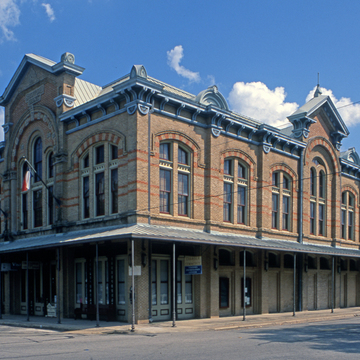This massive, two-story Second Empire building is an unusual combination of a bank on the first floor and opera house on the expansive second floor. The brick building is heavily decorated with articulated arched windows and polychromatic brick combinations. It is one of the few extant buildings outside of Galveston designed by Clayton, one of the state's foremost nineteenth-century architects. In the celebrations following the laying of the courthouse cornerstone on July 7, 1890, the opera house's owner, Robert Stafford, and his brother were killed in an argument with city marshal Larkin Hope.
Across the street at 1220 Milam Street is the austere Caledonia Masonic Lodge No. 68 of 1927. The two-story building is one of the oldest Masonic lodges in Texas, chartered on January 24, 1851.


